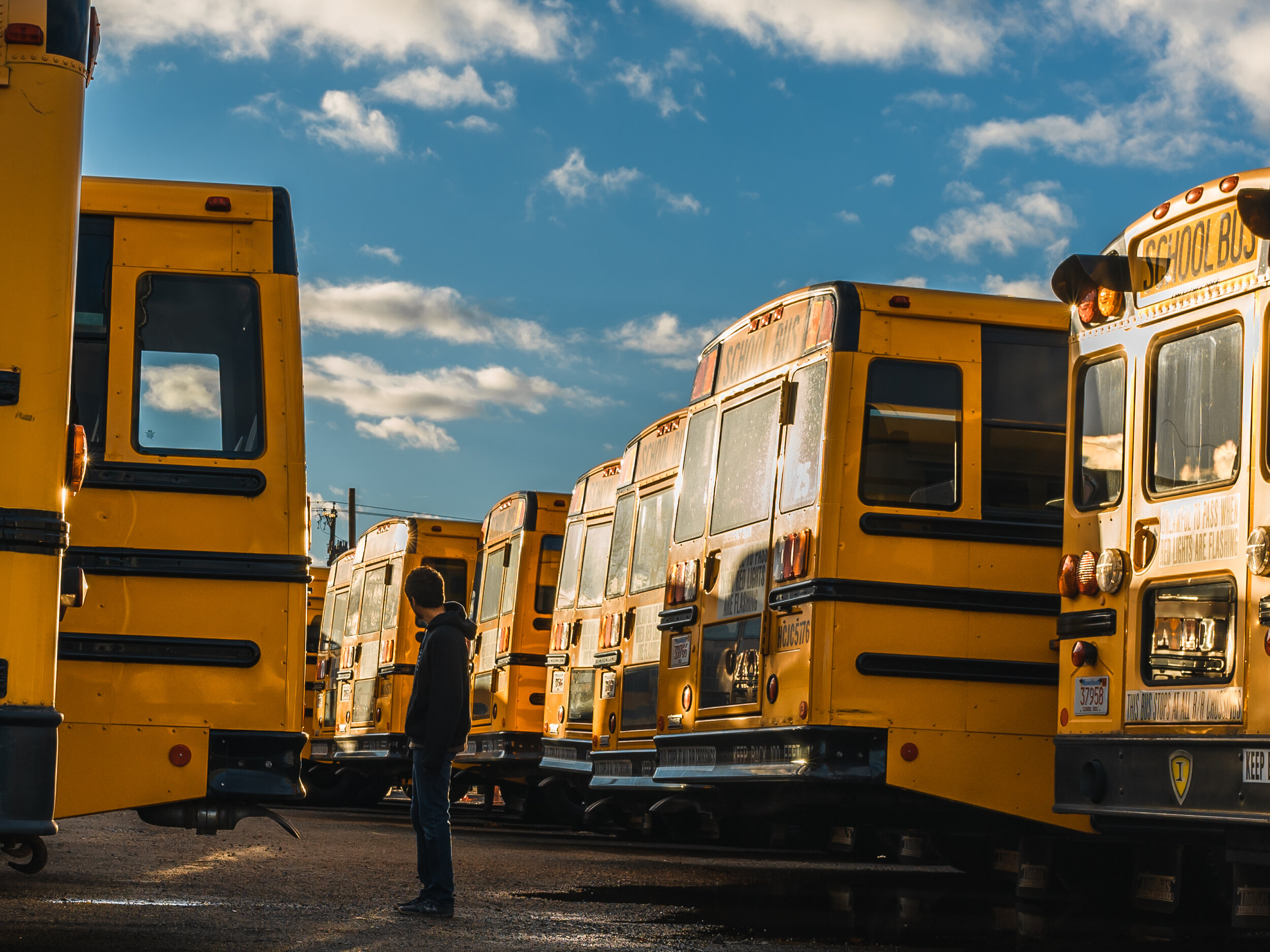Buying a school bus can be a daunting task, but it doesn’t have to be! Here are a few tips to keep in mind when you go to look a bus over and don’t forget to check out our Where To Buy A School Bus Cheatsheet!
Tip #1: Rust
When buying a school bus, check for rust and pay special attention to the undercarriage. This will give you a good indication of the condition of the floor. Buses from the Midwest and Northeast regions are notorious for having rust. Some rust is okay, but you need a solid foundation. If rust is present, you will need to repair the damage before building on top of it. Sometimes this means major repairs involving welding and patching spots like stairwells and wheel wells. This can be very costly and take a lot of time not budgeted in your original build plans.
Tip #2: Diesel engine
Be sure to purchase a diesel engine. Diesels are known to last longer and get better mileage than gasoline engines. Look under the hood for excessive leaks on, around, and under the engine. Look at the condition of the oil and transmission fluids. Open the hood/engine cover and look on top of the engine. Crawl under the bus and look for signs of both old and active leaks. Check the fluid levels and even smell the fluids. Do they smell burnt? Is the transmission fluid really dark? Are the fluids low? These are all indicators of how well the bus was maintained. Some leaks could be as simple as tightening a hose clamp, while others, like a rear main seal, could be very costly to repair.
Wear old clothes and bring a good flashlight to look everything over. The flashlight on your phone is not going to cut it! Start at the front of the engine and work back to the transmission. Purchasing a bus with a service record included is ideal and you should absolutely ask if one is available. Hiring a diesel mechanic to look at the bus prior to purchase is worth the cost, especially if you are not familiar with diesel engines. This could help give you a little more peace of mind when buying a school bus, but remember that they won’t be able to give you a full history or predict every future problem.
Tip #3: Scangauge D
Purchase a Scangauge D and hook it up to the diagnostic port (usually under the dash) to see if the bus has trouble codes. If the bus has active trouble codes, it will tell you. For under $200, it’s a good investment and also helpful when driving the bus as it provides extra gauges and fuel monitoring. I would highly suggest this if you don’t have a mechanic available to take a look at the bus prior to purchase. If you are considering buying a bus built before 1996, keep in mind that it will not have an onboard diagnostic port.
Tip #4: Brakes
Hydraulic vs. Air Brakes: In regards to safety, air brakes are preferred. If the brakes go out and the bus has air brakes, it will cruise to a stop rather than continuing on. Check your state laws for requirements for driving a bus with air brakes. Hydraulic brakes are just like the brakes in your car. They use pressurized fluid to brake where air brakes use air. Air brakes take some time to get used to when first driving, so watch a few YouTube videos on what to expect and how to operate them before you take a test drive.
You should do a visual inspection and basic driving inspection for both types. For visual inspection of hydraulic brakes, you are looking for fluid leaks from the brake manifold to all of the brakes. Fluid leaks can cause brake failure. Pay attention during the test drive to basic stopping and emergency stopping. How does it respond? Is it slow to stop or does it pull to a certain side?
Testing an air brake system is a bit more involved. For a visual test, look at the numerous air fittings and oil residue around the fittings is a sign of a leak. Next, start the bus and let it build up pressure. You should hear a “pssssh” of air around 120-125 psi. This is normal. You will also need to check the compressor. With the engine still running and the parking brake set, pump the brakes several times and watch your air gauge drop to around 90 psi. Around this point, you should see the air pressure needle rise and hear the “pssssh” sound around the 120-125 psi mark. This quick test tells you that the air compressor and the governor are working properly. After the system is fully pressurized, turn off the bus and walk around it outside listening for leaking air. This is a tell-tale sign that you have a leak in the air system. After that, perform a test drive that includes both basic and emergency stopping.
Tip #5: Body Style
Dog Nose vs. Flat: This choice is all about personal preference. A dog nose engine is your typical bus with the engine outside the bus under a hood. This makes it easier to perform maintenance work and repairs. A dog nose also keeps engine noise and heat to a minimum from inside the bus. Dog nose buses are also more common, making them easier to find and purchase.
In our experience, a flat nose bus is easier to drive as you can see the road directly in front of you. Also, it is much easier to make tight turns in a flat nose bus. Keep in mind there are two types of flat nose buses: front engine and rear engine. Front engine buses are warmer and louder inside the bus due to the engine being right next to the driver. Rear engine buses are quieter and not as warm due to the engine being at the back of the bus. Quiet and cool are big advantages! Also, rear engine buses have a shorter drive shaft.
Front versus rear engine will also greatly impact your layout options. Front engine buses typically have less space at the entrance of the bus. One downside of a rear engine bus is that with the bus engine being in the rear, the back of the bus has a raised platform engine housing. Most people put the master bedroom in the rear of a bus and this requires the bed to be on a high platform.
One last advantage to think of when buying a school bus with a flat front; they have more interior space than a dog nose that’s the same overall length!
Tip #6: Interior Height
Buses with a 6’6” interior exist. If a roof raise isn’t in your budget, look for a model that already has a tall interior. Roof raises take extra time, money, and a higher level of skill to complete correctly. When looking at buses, bring a tape measure. Measure the ceiling height and subtract three to four inches. This will give you a good estimate of the finished ceiling height. If you are tall, constantly ducking or leaning over is not fun or comfortable. This is your home or home away from home and it needs to comfortably suit your needs. It might not seem like a big deal when you are inspecting the bus, but this could be a big annoyance once you have it fully constructed. Considering your needs now will avoid regrets after the fact.
Tip #7: Tires
Tires: Bus tires are expensive. Check the date codes and the overall condition of the tires, including whether or not dry rot (cracks in the sidewalls of the tire) is present. If all of the tires need to be replaced, know this could add significantly to the overall bus price. Do not buy a bus with split rims as they have safety issues and most tire repair shops will not work on them.
During your visual inspection of the tires, look for the DOT number on the tire. These are only on one side of the tire. It will have a series of alpha-numeric digits in groups. Look for a 4 digit number. The first two numbers are the week and the last digits are the year the tire was manufactured. A general guideline is if the tire is six years or older from the DOT date, the tires should be replaced regardless of tire wear as a safety precaution.
Tip #8: Leaks
If possible when buying a school bus, visit the bus on a rainy day to check for leaks. Leaks that have been present for a while will have caused significant damage to the walls and/or floors and rust will be a concern. Finding leaks prior to purchasing a bus can give you information on what the condition of the bus could be under the flooring and in the walls. Key areas to examine are the windows, doors, and roof hatches.
Tip #9: Wires
Check the wiring. Field mice and rats love to chew on wires. If it has been sitting for a while, the wires could be in bad shape. Key areas to check for nests and chewed wires are the main fuse panel (typically there is an external access door) and under/around the steering column. A mice problem could cause major issues with the electrical wiring of the bus. Bus electrical issues can be difficult and time consuming to correct due to the sheer amount of wires inside the bus.
Tip #10: Engine + Transmission
Prior to your search, research engines and transmissions. With the excitement of the potential bus build and skoolie lifestyle, one area that could get overlooked is what engine and transmission you should be looking for. Popular diesel engines are the DT466 and 5.9 Cummins. They are popular because they have a reputation for reliability, relative ease to work on, and availability of parts. There are several reputable transmissions, but it really depends on where you plan on doing most of your driving. Some are really good in the mountains, while others are better suited for highway travel. Please consider your travel plans and do your research prior to purchasing a bus.
Buying a school bus is an exciting time, but do not let that excitement blind you into making a regretful decision. If you do your research on the frontside, you’ll make an informed decision and start your skoolie adventure off right.
If you have your school bus and you are ready to hire a builder to help you transform it into your future home on wheels, check out our skoolie build packages and contact us to get your project on the schedule!
We are a part of the Amazon Affiliate program. Some links that you click on may result in us receiving a payment, but not at any cost to you!



